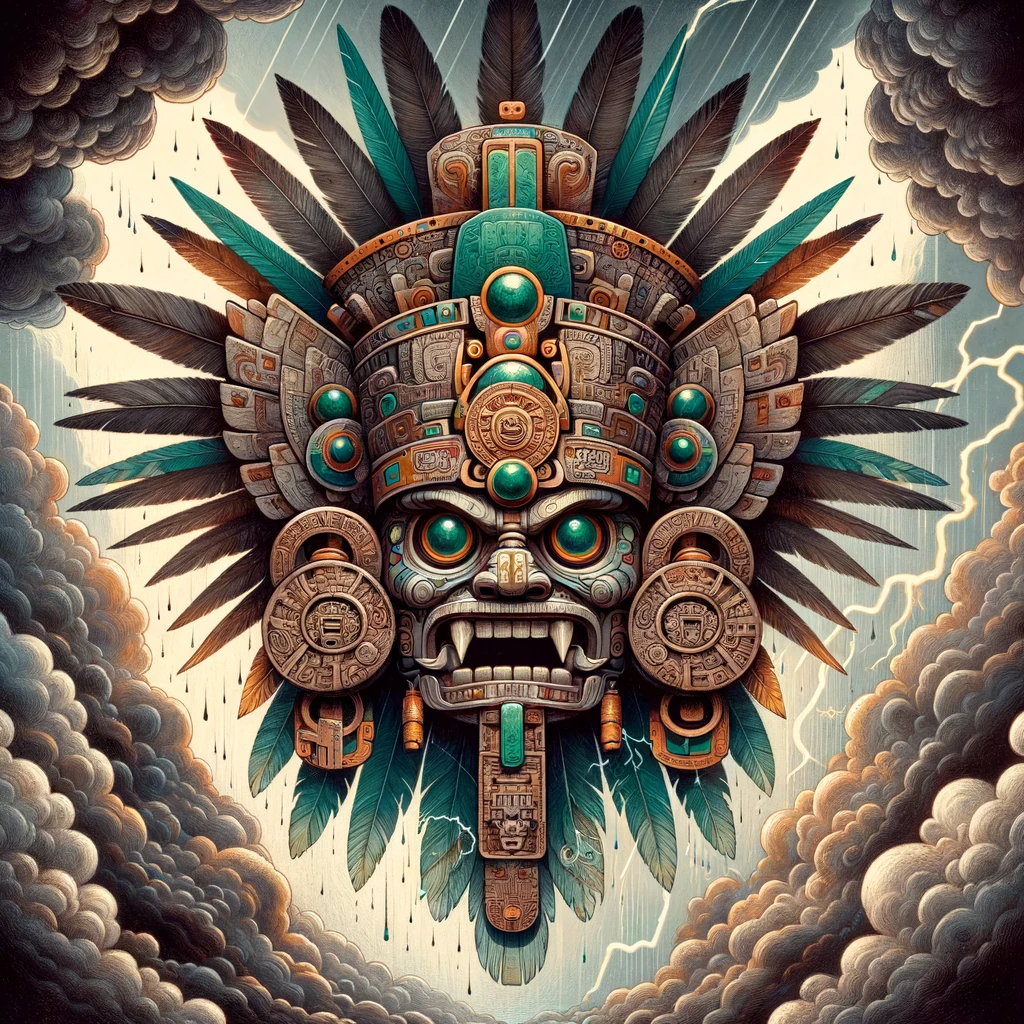
In the pantheon of ancient Aztec deities, Tlaloc holds a prominent place as the god of rain, fertility, and water. This enigmatic figure, adorned in the rich tapestry of Mesoamerican mythology, offers a window into the beliefs, rituals, and worldviews of the Aztec civilization.
Origin and Significance
Tlaloc, whose name could be translated as "He Who Makes Things Sprout," is one of the oldest and most revered gods in the Aztec religion. His origins can be traced back to earlier Mesoamerican cultures, including the Olmecs and the Maya, suggesting a deep-rooted significance in the region's spiritual landscape.
Iconography and Representation
The depiction of Tlaloc is distinct and symbolic. He is often portrayed with goggle-like eyes and fangs, elements that suggest a link to the rain and possibly to agricultural fertility. His image appears in various forms of art, from monumental sculptures to delicate feather paintings, each representation echoing his vital role in Aztec society.
The Role of Tlaloc in Aztec Society
Tlaloc was more than a mere symbol; he was integral to the daily and seasonal lives of the Aztecs. As a rain deity, he was crucial for agriculture, particularly in a region where water was both scarce and vital. The Aztecs believed that by appeasing Tlaloc, they could ensure regular rainfall, which was essential for growing maize, their staple crop.
Rituals and Ceremonies
To honor Tlaloc, the Aztecs engaged in complex rituals and ceremonies. These included elaborate dances, processions, and offerings. Notably, Tlaloc was also associated with a form of child sacrifice, a practice that has been a subject of much historical debate and reflection. It was believed that the tears of children, especially those of young boys, would appease Tlaloc and ensure rain.
Tlaloc and the Tlaloque
Tlaloc was not alone in his reign over the waters. He was accompanied by lesser deities known as the Tlaloque, who were believed to reside on the mountaintops, releasing rain and thunderstorms at Tlaloc’s command.
The Dual Nature of Tlaloc
Reflecting the dualism inherent in many Mesoamerican belief systems, Tlaloc was both a giver and a taker. While he provided life-giving rain and fertility, he could also unleash floods, droughts, and thunderstorms, reflecting nature's unpredictable and often destructive power.
Tlaloc in Modern Culture
Today, Tlaloc continues to be a figure of interest and study. He is not only a subject of historical and archaeological investigation but also features in modern artistic and cultural expressions, symbolizing the enduring legacy of the Aztec civilization.
Conclusion
Tlaloc, the Aztec god of rain, fertility, and water, stands as a testament to the rich spiritual and cultural heritage of the Aztec people. His worship, encompassing both fear and reverence, highlights the deep connection the Aztecs had with the natural world, a relationship that continues to intrigue and inspire people around the globe.
Origin and Significance
Tlaloc, whose name could be translated as "He Who Makes Things Sprout," is one of the oldest and most revered gods in the Aztec religion. His origins can be traced back to earlier Mesoamerican cultures, including the Olmecs and the Maya, suggesting a deep-rooted significance in the region's spiritual landscape.
Iconography and Representation
The depiction of Tlaloc is distinct and symbolic. He is often portrayed with goggle-like eyes and fangs, elements that suggest a link to the rain and possibly to agricultural fertility. His image appears in various forms of art, from monumental sculptures to delicate feather paintings, each representation echoing his vital role in Aztec society.
The Role of Tlaloc in Aztec Society
Tlaloc was more than a mere symbol; he was integral to the daily and seasonal lives of the Aztecs. As a rain deity, he was crucial for agriculture, particularly in a region where water was both scarce and vital. The Aztecs believed that by appeasing Tlaloc, they could ensure regular rainfall, which was essential for growing maize, their staple crop.
Rituals and Ceremonies
To honor Tlaloc, the Aztecs engaged in complex rituals and ceremonies. These included elaborate dances, processions, and offerings. Notably, Tlaloc was also associated with a form of child sacrifice, a practice that has been a subject of much historical debate and reflection. It was believed that the tears of children, especially those of young boys, would appease Tlaloc and ensure rain.
Tlaloc and the Tlaloque
Tlaloc was not alone in his reign over the waters. He was accompanied by lesser deities known as the Tlaloque, who were believed to reside on the mountaintops, releasing rain and thunderstorms at Tlaloc’s command.
The Dual Nature of Tlaloc
Reflecting the dualism inherent in many Mesoamerican belief systems, Tlaloc was both a giver and a taker. While he provided life-giving rain and fertility, he could also unleash floods, droughts, and thunderstorms, reflecting nature's unpredictable and often destructive power.
Tlaloc in Modern Culture
Today, Tlaloc continues to be a figure of interest and study. He is not only a subject of historical and archaeological investigation but also features in modern artistic and cultural expressions, symbolizing the enduring legacy of the Aztec civilization.
Conclusion
Tlaloc, the Aztec god of rain, fertility, and water, stands as a testament to the rich spiritual and cultural heritage of the Aztec people. His worship, encompassing both fear and reverence, highlights the deep connection the Aztecs had with the natural world, a relationship that continues to intrigue and inspire people around the globe.